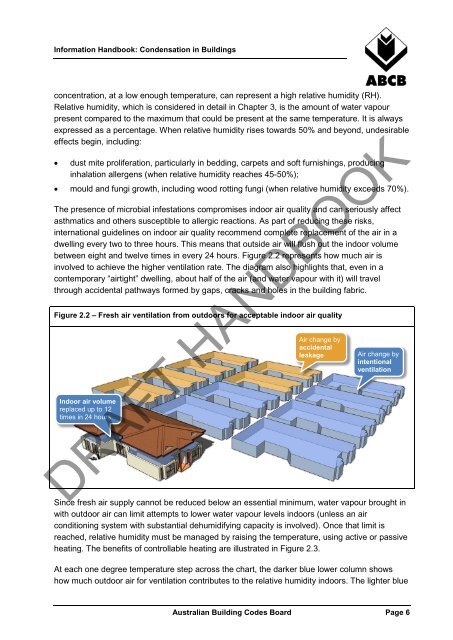Condensation in Buildings - Australian Building Codes Board
Condensation in Buildings - Australian Building Codes Board
Condensation in Buildings - Australian Building Codes Board
Create successful ePaper yourself
Turn your PDF publications into a flip-book with our unique Google optimized e-Paper software.
Information Handbook: <strong>Condensation</strong> <strong>in</strong> Build<strong>in</strong>gs<br />
concentration, at a low enough temperature, can represent a high relative humidity (RH).<br />
Relative humidity, which is considered <strong>in</strong> detail <strong>in</strong> Chapter 3, is the amount of water vapour<br />
present compared to the maximum that could be present at the same temperature. It is always<br />
expressed as a percentage. When relative humidity rises towards 50% and beyond, undesirable<br />
effects beg<strong>in</strong>, <strong>in</strong>clud<strong>in</strong>g:<br />
• dust mite proliferation, particularly <strong>in</strong> bedd<strong>in</strong>g, carpets and soft furnish<strong>in</strong>gs, produc<strong>in</strong>g<br />
<strong>in</strong>halation allergens (when relative humidity reaches 45-50%);<br />
• mould and fungi growth, <strong>in</strong>clud<strong>in</strong>g wood rott<strong>in</strong>g fungi (when relative humidity exceeds 70%).<br />
The presence of microbial <strong>in</strong>festations compromises <strong>in</strong>door air quality and can seriously affect<br />
asthmatics and others susceptible to allergic reactions. As part of reduc<strong>in</strong>g these risks,<br />
<strong>in</strong>ternational guidel<strong>in</strong>es on <strong>in</strong>door air quality recommend complete replacement of the air <strong>in</strong> a<br />
dwell<strong>in</strong>g every two to three hours. This means that outside air will flush out the <strong>in</strong>door volume<br />
between eight and twelve times <strong>in</strong> every 24 hours. Figure 2.2 represents how much air is<br />
<strong>in</strong>volved to achieve the higher ventilation rate. The diagram also highlights that, even <strong>in</strong> a<br />
contemporary “airtight” dwell<strong>in</strong>g, about half of the air (and water vapour with it) will travel<br />
through accidental pathways formed by gaps, cracks and holes <strong>in</strong> the build<strong>in</strong>g fabric.<br />
Figure 2.2 – Fresh air ventilation from outdoors for acceptable <strong>in</strong>door air quality<br />
Indoor air volume<br />
replaced up to 12<br />
times <strong>in</strong> 24 hours<br />
Air change by<br />
accidental<br />
leakage<br />
Air change by<br />
<strong>in</strong>tentional<br />
ventilation<br />
DRAFT HANDBOOK<br />
S<strong>in</strong>ce fresh air supply cannot be reduced below an essential m<strong>in</strong>imum, water vapour brought <strong>in</strong><br />
with outdoor air can limit attempts to lower water vapour levels <strong>in</strong>doors (unless an air<br />
condition<strong>in</strong>g system with substantial dehumidify<strong>in</strong>g capacity is <strong>in</strong>volved). Once that limit is<br />
reached, relative humidity must be managed by rais<strong>in</strong>g the temperature, us<strong>in</strong>g active or passive<br />
heat<strong>in</strong>g. The benefits of controllable heat<strong>in</strong>g are illustrated <strong>in</strong> Figure 2.3.<br />
At each one degree temperature step across the chart, the darker blue lower column shows<br />
how much outdoor air for ventilation contributes to the relative humidity <strong>in</strong>doors. The lighter blue<br />
<strong>Australian</strong> Build<strong>in</strong>g <strong>Codes</strong> <strong>Board</strong> Page 6
















